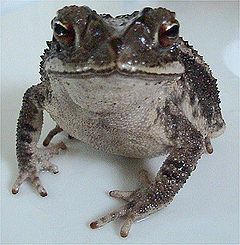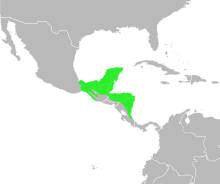- Gulf Coast toad
-
Gulf Coast Toad 
Conservation status Scientific classification Kingdom: Animalia Phylum: Chordata Class: Amphibia Order: Anura Family: Bufonidae Genus: Incilius Species: I. valliceps Binomial name Incilius valliceps
Weigmann, 1833
Synonyms Bufo trachypus
Bufo valliceps[2]
Cranopsis valliceps
Ollotis vallicepsThe Gulf Coast Toad (Incilius valliceps) is a species of toad native to the southern United States (Texas, Louisiana), Mexico, and Central America as far south as Costa Rica.[3]
Contents
Description
The Gulf Coast Toad is a medium sized toad species, ranging from 2 to 4 in (5.1 to 10 cm) in length.[4] Their back varies in color from nearly black, to shades of brown and grey with a distinctive white or yellowish colored stripe down the center, and sometimes lighter colored patches on the sides. Their underside is yellow or cream colored. Their back is covered in small tubercles, while their underside is normally devoid of them.
I. valliceps has the most extensive ridging of any toad in its geographic range. The ridges extend from the nose, to the back of the head, and with a branch that wraps around the back side of the eye.
Habitat
The Gulf Coast Toad is found in a wide range of habitats, including open grassland, semi-arid regions, light forest, and even suburban backyards. They are typically found not far from a permanent water source, which they use for breeding in the spring, but they are capable of travelling long distances while foraging for food.
Diet
Like most toads, the Gulf Coast Toad is an opportunistic carnivore. It will eat almost any small arthropod it is able to overpower and swallow.
References
- ^ Santos-Barrera et al. (2004). Bufo valliceps. 2006. IUCN Red List of Threatened Species. IUCN 2006. www.iucnredlist.org. Retrieved on 12 May 2006. Database entry includes a range map and justification for why this species is of least concern
- ^ "Bufo valliceps". Integrated Taxonomic Information System. http://www.itis.gov/servlet/SingleRpt/SingleRpt?search_topic=TSN&search_value=773594. Retrieved 22 October 2009.
- ^ Conant, Roger; Joseph T. Collins (1998). A Field Guide to Reptiles & Amphibians: Eastern and Central North America (3 ed.). Houghton Mifflin Harcourt. pp. 521–522. ISBN 9780395904527. http://books.google.com/?id=EUttwDQl83sC.
- ^ "Bufo valliceps Gulf Coast Toad". Herps of Texas. University of Texas at Austin. http://www.zo.utexas.edu/research/txherps/frogs/bufo.valliceps.html. Retrieved 2009-10-22.
- Pauly, G. B., D. M. Hillis, and D. C. Cannatella. (2004) The history of a Nearctic colonization: Molecular phylogenetics and biogeography of the Nearctic toads (Bufo). Evolution 58: 2517–2535.
- Frost, Darrel et al.; Grant, Taran; Faivovich, Julián; Bain, Raoul H.; Haas, Alexander; Haddad, Célio F.B.; De Sá, Rafael O.; Channing, Alan et al. (2006). "The Amphibian Tree of Life". Bulletin of the American Museum of Natural History 297: 364. doi:10.1206/0003-0090(2006)297[0001:TATOL]2.0.CO;2.
Categories:- IUCN Red List least concern species
- Toads
- Amphibians of the United States
- Amphibians of Mexico
- Amphibians of Central America
- Amphibians of Guatemala
- Animals described in 1833
- Amphibians of Belize
- Amphibians of Costa Rica
- Amphibians of El Salvador
- Amphibians of Honduras
- Fauna of Nicaragua
Wikimedia Foundation. 2010.


